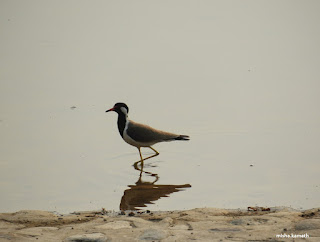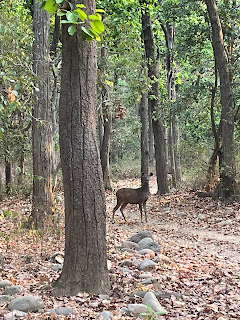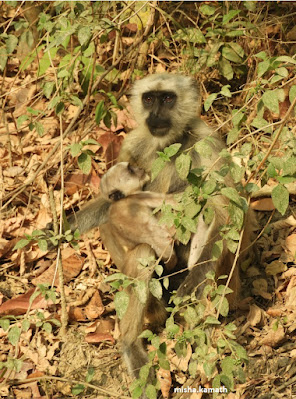The drive from Rishikesh to Ramnagar turned out to be longer than expected. Of course, it lasted the predicted 4 hours, but the near arid landscape and the scorching heat seemed to drag every minute of those four hours. The passing vistas were interesting enough until a little after we passed through Haridwar, after that, it was dusty roads, vast open fields & a whole lot of sunshine bouncing off every surface. The high point was being assured that it’d be cooler in the forest.
Mumbai à Mussoorie à Rishikesh à Jim Corbett à Nainital à Amritsar
Halfway to Ramnagar, we stopped at Raj Chole Bhature, a little hotel/dhaba where we shared a delicious paratha with some great chutney, and a tall glass of mildly spiced buttermilk.
That got us through the rest of the way until our driver, who was in a mighty hurry, dropped us off at Ramnagar, the gateway to the Jim Corbett National Park.
We had booked
ourselves a two-day stay inside the park through Boon Travels (7617777017) and
had managed to get a room at the Malani FRH in the Bijrani Zone. Unlike most of
the FRHs in the four other zones within the Park, Malani FRH does not have a
canteen facility. Instead, there’s a kitchen and a cook. The drawback is that
we’re supposed to bring with us all the ingredients and raw materials we might
require for all our meals, for the duration of our stay. Finding that to be
quite tiresome, we took the easy way out and purchased ingredients for tea,
some eggs and a whole lot of Maggi. Unknown to us, however, was the unspoken
expectation that we were also to provide for the guide and the cook as well.
Needless to say, they were quite disappointed with our shopping.
Liberally scattered around Ramnagar are many hotels offering a Corbett experience, but while these do offer a safari in the forest, they, most often, cannot venture in the interior of the forest. Moreover, once the safari is done, it’s just another hotel room no different from any other.
Shoaib, the
guide/driver assigned to us picked us up outside the Government College,
Ramnagar, stopped a while to let us shop for er…groceries, and then, at our
request, stopped for lunch at the Shan-a-Punjab restaurant. Food here is
delicious and flavourful.
While we wait here, it’s a good time to pass on some info about the Jim Corbett National Park, the first national park in India, established in 1936. Nearly a decade after India’s independence, it was named after Jim Corbett, the hunter and naturalist who’d played a leading role in its establishment. It is a very popular ecotourism destination & the first park to come under the Project Tiger initiative. Of all its five eco-zones, Dhikala is most sought after for Tiger sightings, the next being the Bijrani Zone. Jhirna boasts of bear sightings while the area around Malani FRH is great for bird watching. The Park is closed to tourists during the monsoons, and it would be a wise idea to book your stay well in advance (at least 3 months) to ensure you get accommodation in the zone of your choice.
Our stay inside the park included accommodation and four safaris through the forest, each lasting a good four hours. With our bags still stacked neatly at the back of the jeep, we began our first safari.
Shoaib was quite
helpful in guiding us with dos and don’ts, and was also quite knowledgeable about
the flora and fauna we spotted as we silently drove along the narrow track.
Ever so often, we stopped and maintained a watchful silence, looking for any
sign that Mr. Tiger might be prowling around.
The first
creature we spotted was the regal peacock, almost hidden from view, strutting
along his way. At many places we also spotted many gigantic termite mounds,
remarkable natural constructions that are sometimes occupied by snakes, as
well. What was astonishing to learn is that these termites are master
architects. These insects create their own air conditioning system that
circulates hot & cool air, keeping the inside temperature constant in spite
of the many fluctuations outside the mound.
Shoaib also
pointed out to us different types of deer, namely the Spotted Deer, the Barking
Deer and, largest of all, the Sambar. The latter, we are told, is the Tiger’s
favourite meal. Just one Sambar kill can last Mr. Tiger days and ensures
that he feasts like the king that he is.
After a few more hours of enjoying forest sounds and spotting a myriad of birdies, we arrived at Malani FRH.
Malani FRH is located 12kms
northwest of Bijrani, on the edge of the core zone of the Tiger reserve. The
main house consists of a large common room of sorts, a kitchen and two guest
rooms, each with its own private bathroom. Ours was the smaller of the two
rooms, but very comfortable. This FRH is fairly secluded and is the perfect
place to enjoy the forest all around. After sunset, it gets so dark, you can
sit stargazing for hours while listening to the sounds of the creatures of the
night. You can also watch the lightening bugs and pretend they’re shooting
stars.
Sometime in the night, I heard a roar in the distance and saw a herd of deer run by the window.
Safaris continue…
Early the next
morning, at 6.15am, we were back in the jeep ready for a morning safari.
Although we stayed within our assigned zone, we kept switching between tracks,
going back & forth, seeing what we could see. Not much luck seeing Mr.
Tiger today, but we did enjoy looking out for birds, monkeys and a crocodile.
And, of course, peacocks a-plenty!
 |
| Spotted Dove |
 |
| Green Bee-eater |
 |
| Emerald Dove |
 |
| Red Jungle Fowl (female) |
 |
| Red Wattled Lapwing |
 |
| Golden Backed Woodpecker |
 |
| Crocodile |
In addition to all of the above, we also spotted some Babblers, Orioles (the golden ones & the black hooded ones), Woodpeckers, a Hornbill, Barbets, Drongos, Thrushes, Magpies, a Himalayan Red Bulbul, regular Red-bum Bulbuls, Kingfishers, an Eagle, an Asian Paradise Flycatcher and some Wild Boar.
B.t.w, there are two types of monkeys pointed out to us by Shoaib, the Langoor and the Macaque.
Shoaib also stopped us at a watering hole to watch a fairly large herd of deer quench their thirst.
During the evening safari that begins at 3pm, we spotted more of the same beautiful creatures, and pug marks.
We crossed paths with a few other jeeps all of whose
occupants seemed most disappointed at not having spotted a Tiger. If that’s all
they came for, I’m not sure they enjoyed the safari at all. If one is so focused
on looking only for a particular creature, methinks they risk turning blind to
everything else the forest has to offer.
For us who
live in a city, a forest is breathtakingly beautiful. The shapes and colours of
the trees, the sunlight filtering through the leaves, the sounds of the fallen
leaves and the wind in the trees, the soothing fragrance of the forest and the
silence broken only by calls of birds and animals. It’s an amazing experience,
truly!
And it pays to be attentive. Mr. Tiger finally put in a brief appearance a few meters in front of our jeep. It took us by complete surprise! We couldn’t believe our eyes. It happened so quickly, that by the time we fished out our cameras, all we got was his striped tail swishing away as he disappeared in the bushes. How glad we were that we’d seen the Tiger! From then on, every other jeep we met was told of our success while we sat grinning happily from ear to ear. It was all we could speak of for the rest of the safari.
 |
| Royal Bengal Tiger...(pic taken later at Naini Zoo) |
Mr. Peacock & his other members of his clan kept proclaiming their presence and making regular appearances. And we soon discovered why as dark clouds shrouded the sun and the heavens rained down on us, dousing us with icy cold raindrops. What an experience that was! We enjoyed the rain for as long as we could, but then, wanting to avoid being stranded in the forest, we cut short the safari and headed back to the guesthouse and called it a day.
Next morning, packed and ready, we got into the jeep for our final safari before check-out. Started out on a different track this time and saw a lot of trees that had fallen during last evening’s sudden rainstorm. A couple of them had been felled by elephants, as well. No tiger this morning, but plenty of tracks to keep us hoping. Back at the watering hole, we noticed the presence of lots of tourist-filled jeeps. These were largely outside tourists who had signed up for just a single safari experience.
Our Corbett experience completed, Shoaib drove us to a restaurant outside the reserve, for a late breakfast. He also assisted us in getting a cab to drive us about 2 hours away to our next destination.
The stay inside the Park had been an enjoyable experience and one that was so very different from others. While we drove away from Corbett I sat back, mentally calculating how many months had to go by before I could book another stay here. That done, I brought my mind back to the present and settled down to enjoy the journey ahead.
Pics by Misha.





























1 comment:
Such a compelling account of your stay at Jim Corbett. Definitely on my list of places to visit. Lovely photographs.
Post a Comment